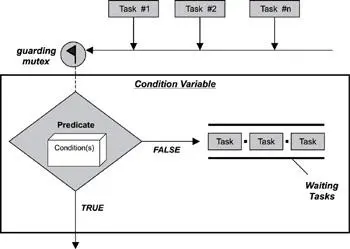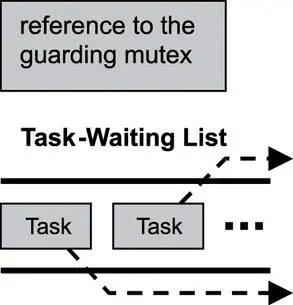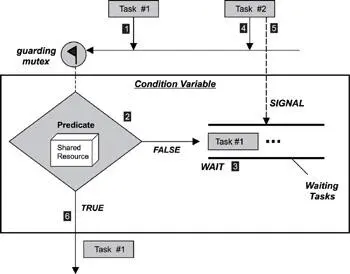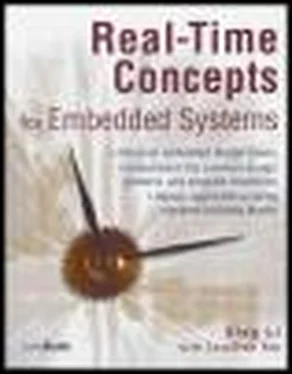As shown in Figure 8.13, a condition variable implements a predicate. The predicate is a set of logical expressions concerning the conditions of the shared resource. The predicate evaluates to either true or false. A task evaluates the predicate. If the evaluation is true, the task assumes that the conditions are satisfied, and it continues execution. Otherwise, the task must wait for other tasks to create the desired conditions.

Figure 8.13: Condition variable.
When a task examines a condition variable, the task must have exclusive access to that condition variable. Without exclusive access, another task could alter the condition variable's conditions at the same time, which could cause the first task to get an erroneous indication of the variable's state. Therefore, a mutex is always used in conjunction with a condition variable. The mutex ensures that one task has exclusive access to the condition variable until that task is finished with it. For example, if a task acquires the mutex to examine the condition variable, no other task can simultaneously modify the condition variable of the shared resource.
A task must first acquire the mutex before evaluating the predicate. This task must subsequently release the mutex and then, if the predicate evaluates to false, wait for the creation of the desired conditions. Using the condition variable, the kernel guarantees that the task can release the mutex and then block-wait for the condition in one atomic operation, which is the essence of the condition variable. An atomic operation is an operation that cannot be interrupted.
Remember, however, that condition variables are not mechanisms for synchronizing access to a shared resource. Rather, most developers use them to allow tasks waiting on a shared resource to reach a desired value or state.
8.5.1 Condition Variable Control Blocks
The kernel maintains a set of information associated with the condition variable when the variable is first created. As stated previously, tasks must block and wait when a condition variable's predicate evaluates to false. These waiting tasks are maintained in the task-waiting list. The kernel guarantees for each task that the combined operation of releasing the associated mutex and performing a block-wait on the condition will be atomic. After the desired conditions have been created, one of the waiting tasks is awakened and resumes execution. The criteria for selecting which task to awaken can be priority-based or FIFO-based, but it is kernel-defined. The kernel guarantees that the selected task is removed from the task-waiting list, reacquires the guarding mutex, and resumes its operation in one atomic operation. The essence of the condition variable is the atomicity of the unlock-and-wait and the resume-and-lock operations provided by the kernel. Figure 8.14 illustrates a condition variable control block.

Figure 8.14: Condition variable control block.
The cooperating tasks define which conditions apply to which shared resources. This information is not part of the condition variable because each task has a different predicate or condition for which the task looks. The condition is specific to the task. Chapter 15 presents a detailed example on the usage of the condition variable, which further illustrates this issue.
8.5.2 Typical Condition Variable Operations
A set of operations is allowed for a condition variable, as shown in Table 8.7.
Table 8.7: Condition variable operations.
| Operation |
Description |
| Create |
Creates and initializes a condition variable |
| Wait |
Waits on a condition variable |
| Signal |
Signals the condition variable on the presence of a condition |
| Broadcast |
Signals to all waiting tasks the presence of a condition |
The create operation creates a condition variable and initializes its internal control block.
The wait operation allows a task to block and wait for the desired conditions to occur in the shared resource. To invoke this operation, the task must first successfully acquire the guarding mutex. The wait operation puts the calling task into the task-waiting queue and releases the associated mutex in a single atomic operation.
The signal operation allows a task to modify the condition variable to indicate that a particular condition has been created in the shared resource. To invoke this operation, the signaling task must first successfully acquire the guarding mutex. The signal operation unblocks one of the tasks waiting on the condition variable. The selection of the task is based on predefined criteria, such as execution priority or system-defined scheduling attributes. At the completion of the signal operation, the kernel reacquires the mutex associated with the condition variable on behalf of the selected task and unblocks the task in one atomic operation.
The broadcast operation wakes up every task on the task-waiting list of the condition variable. One of these tasks is chosen by the kernel and is given the guarding mutex. Every other task is removed from the task-waiting list of the condition variable, and instead, those tasks are put on the task-waiting list of the guarding mutex.
8.5.3 Typical Uses of Condition Variables
Listing 8.1 illustrates the usage of the wait and the signal operations.
Listing 8.1: Pseudo code for wait and the signal operations.
Task 1
Lock mutex
Examine shared resource
While (shared resource is Busy)
WAIT (condition variable)
Mark shared resource as Busy
Unlock mutex
Task 2
Lock mutex
Mark shared resource as Free
SIGNAL (condition variable)
Unlock mutex
Task 1 on the left locks the guarding mutex as its first step. It then examines the state of the shared resource and finds that the resource is busy. It issues the wait operation to wait for the resource to become available, or free. The free condition must be created by task 2 on the right after it is done using the resource. To create the free condition, task 2 first locks the mutex; creates the condition by marking the resource as free, and finally, invokes the signal operation, which informs task 1 that the free condition is now present.
A signal on the condition variable is lost when nothing is waiting on it. Therefore, a task should always check for the presence of the desired condition before waiting on it. A task should also always check for the presence of the desired condition after a wakeup as a safeguard against improperly generated signals on the condition variable. This issue is the reason that the pseudo code includes a while loop to check for the presence of the desired condition. This example is shown in Figure 8.15.

Figure 8.15: Execution sequence of wait and signal operations.
Some points to remember include the following:
· Pipes provide unstructured data exchange between tasks.
· The select operation is allowed on pipes.
· Event registers can be used to communicate application-defined events between tasks.
Читать дальше















